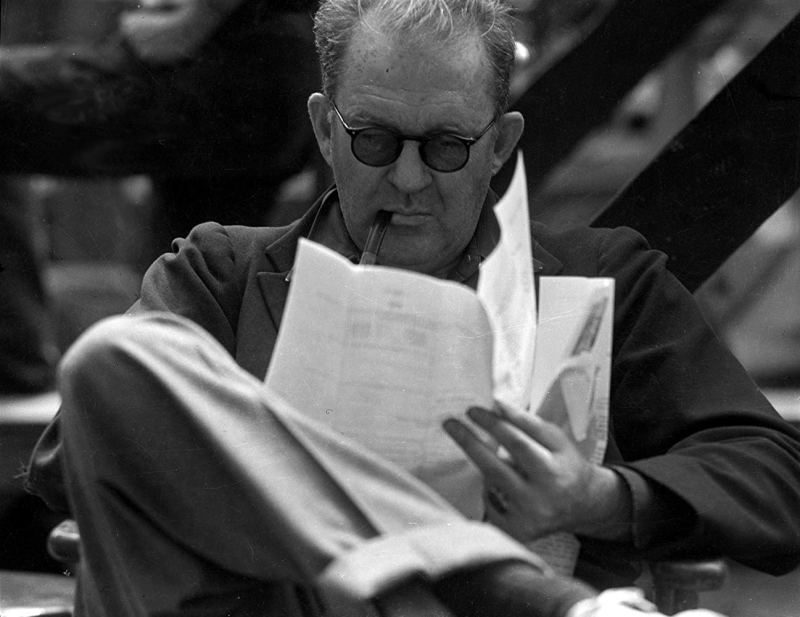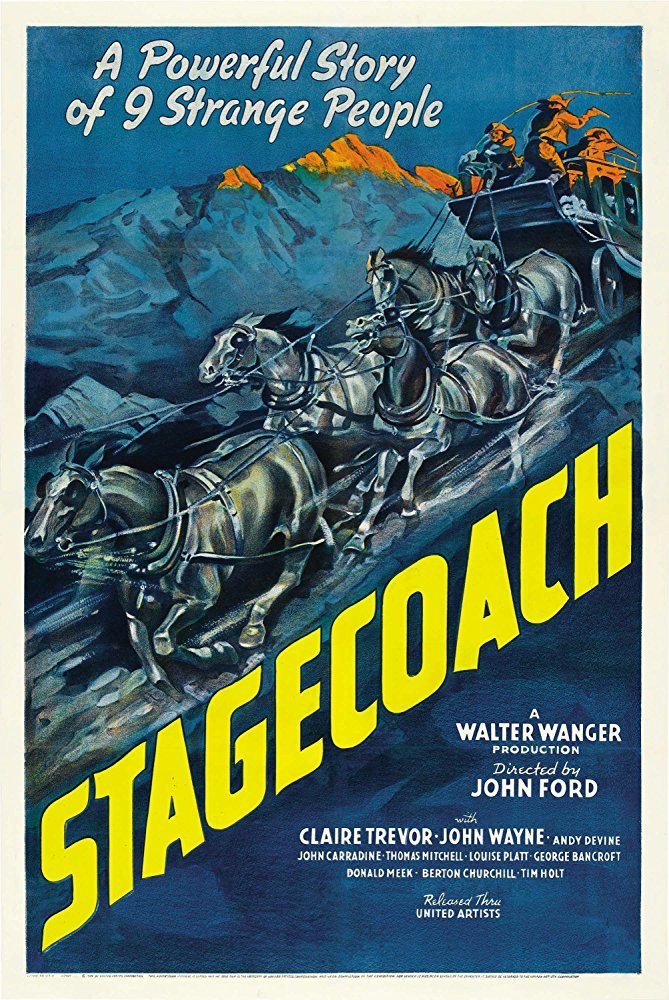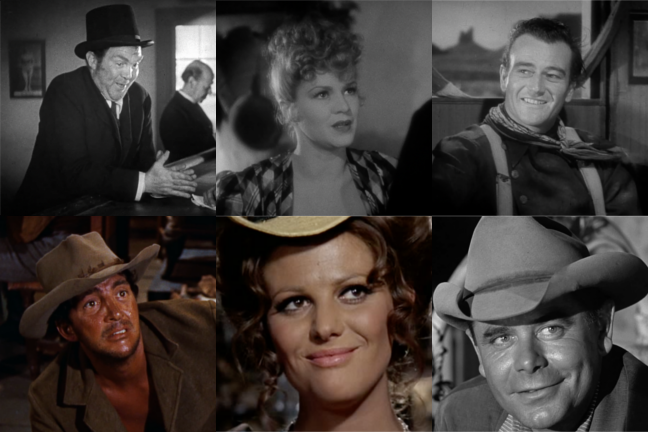The western genre might be the most important American contribution to cinema. With Edwin S. Porter’s The Great Train Robbery (1903) typically cited as the first of the genre, westerns are as old as the craft of filmmaking itself, and would remain one of the most popular genres until the late 60s. Themes of morally righteous men doling out justice and paving the path of the American frontier resonated strongly with audiences, and had a profound impact that is still evident in the stories of today. The western hero has transcended the medium and become an icon of integrity and gallantry, a symbol erected by pioneer filmmakers. They set their heroes against backdrops of sweeping vistas that exemplified the pure Americana of the genre. No one, however, contributed more to the realization of the western genre than acclaimed director John Ford, a man so closely associated with it, he once introduced himself thusly: “My name’s John Ford. I make Westerns.”

Ford was a monumental figure whose influence can be seen throughout the works of Steven Spielberg, Martin Scorsese, and perhaps most famously, Akira Kurosawa. Orson Welles was once asked who his favorite directors were. He responded: “I prefer the old masters, by which I mean John Ford, John Ford, and John Ford. He’s a poet and a comedian. With Ford at his best you get a sense of what the Earth was made of.” Welles was so enamored with the director that during preparation for his first film he reportedly screened Stagecoach (1939) some 40 times, later stating: “John Ford was my teacher. My own style had nothing to do with his, but Stagecoach was my movie textbook… I wanted to learn how to make movies, and that’s such a classically perfect one.” It was Ford’s first western in 13 years and his first of the sound era, a landmark masterpiece that marked not only a new beginning for Ford, but for the genre as a whole.

The tagline of the film, “A Powerful Story of 9 Strange People,” is deceptively simple. A group of people with conflicting personalities are shoved together on a trip through dangerous Indian territory, and must work together to arrive safely at their collective destination. What sets Stagecoach apart from the previous decade’s westerns, though, was Ford’s focus on characters with depth and social commentary, things that the genre had been lacking. Despite their popularity, silent westerns were seen as little more than innocuous entertainment and relegated to B-List status. Stagecoach made way for more thought-provoking classics like The Ox-Bow Incident (1943), Red River (1948), and High Noon (1952), not to mention Ford’s own The Searchers (1956) and The Man Who Shot Liberty Valance (1962). The ingenuity of Stagecoach made it a pillar of the genre, establishing new expectations for all subsequent westerns to adhere to. The combination of the film’s progressive characters, defining set pieces, and visual mastery created an ideal vision of the American West that has become the basis of comparison for every western to come thereafter.
Stagecoach is first and foremost an ensemble film. Each character is given ample time and thorough resolution. It’s a notably large ensemble as well, one that showcases most of the characters found in the western genre up until that point. Ringo (played by John Wayne, in his star-making role) and Curley (George Bancroft) are the outlaw and sheriff, both pervasive characters that dominate the genre. The devilish Hatfield (Ford regular John Carradine) and comical Doc Boone (in an Oscar-Winning performance from Thomas Mitchell) embody the popular gambler and drunk supporting characters. Dallas (top-billed star Claire Trevor), as the hooker-with-a-heart-of-gold, and Mrs. Mallory (Louise Platt), a devoted wife, are polar opposites. The cast is rounded out with Peacock (fittingly played by Donald Meek), Gatewood (Burton Churchill), and Buck (given a special charm by Andy Devine) representing the whiskey salesman, fussy banker, and driver of the eponymous stagecoach.
Each character is given a highlighted introduction which demonstrates their defining characteristics, establishes their place within the status quo, and informs of their reason for journeying to Lordsburg. These introductions showcase how the nine passengers divide evenly into three groups based on how their society values them. A respectable position, an unwavering devotion for her husband, and a chivalrous dedication to her protection earns praise and respect for Gatewood, Mrs. Mallory, and Hatfield, while Doc Boone, Dallas, and Ringo have all been cast out from society, and are treated with disgust and contempt. Curley, Buck, and Peacock, though, remain somewhere in the middle. They are neither especially respected nor condemned and represent the general population, typically treating everyone approximately the same, regardless of their position. The key to the success of Stagecoach, however, lies in Ford’s subversion of these archetypal characters, reversing the expectations of the genre, revealing that the heroes and villains are not always who we think. He does this through clashes in social dynamics that dominate character interactions, beginning after Ringo’s iconic entrance finalizes the traveling band.
Buck and Doc Boone address Ringo amicably, greeting him with friendly recognition, despite his “notorious” reputation, as Gatewood declares. Hatfield makes several brash comments himself during the ride to Dry Forks Station, outing himself as a proud Confederate, and admonishing Doc Boone under the guise of Mrs. Mallory’s protection. At this point, the friction amongst the group has been well established, but their division manifests overtly when they sit down for a meal at the station. Ringo, unaware of Dallas’ objectionable occupation, is courteous and gentlemanly to her, much to the disdain of the rest of the group. He offers her a seat at the table as Gatewood, Hatfield, and Mrs. Mallory share a series of disgusted looks with each other before Hatfield offers to move Mrs. Mallory to the other end of the table, with Gatewood promptly joining them in a rather rude display of snobbishness.
Ringo’s oblivious yet noble gesture is the first indication of Ford’s subversion of western stereotypes. By showing a condemned outlaw to be morally superior to those of the distinguished class, Ford calls into question the entrenched limitations of the genre. This is also apparent in the sympathy other characters share for Ringo’s mission. Even Curley, who came along specifically to put Ringo back in jail, carries out his duties with reservation, seeking only to protect the boy from seemingly inevitable doom. As the coach continues towards Apache Wells, the symptoms of Mrs. Mallory’s hidden pregnancy begin to show. Dallas is the first to offer her assistance, only to be promptly refused. She does however, accept Hatfield’s offer, and takes a drink of water from his silver cup. Ringo again validates Dallas’ dignity, as he had earlier when Curley called for a vote to continue their trek, and offers her a drink as well once Mrs. Mallory has finished. He reaches for the cup, but Hatfield brazenly tucks it back into his pocket. Ringo takes it in stride and offers a charming smile and a cheeky quip.
Almost immediately after arriving at Apache Wells, Mrs. Mallory faints and the others realize she is desperate need of medical attention. Dallas promptly takes charge, and brings Doc Boone along with her to assess the situation. Meanwhile, Gatewood is again complaining about the army before Ringo shuts him up. Dallas then emerges from the back room, ordering Ringo to get hot water, and Doc Boone drunkenly saunters up to the bar. Hatfield calls him a “drunken beast,” but the Doc pays no mind and, with a formerly unknown earnestness, demands strong coffee to restore his sober mind.
Just as Ringo’s kindness at the dinner scene reveals his true self, Dallas and Doc Boone’s assistance in the birth of Mrs. Mallory’s child show theirs. They respond hastily, without regard to the prejudice they have experienced, and rise above their shortcomings to demonstrate their reliability in the face of adversity. The delivery of Mrs. Mallory’s baby marks a turning point in the story, as the characters who began as pariahs are now revered and celebrated, while those who were treated with reverence have shown their true colors. Stagecoach’s subversive characters clearly laid the groundwork for similar characters that would blossom and influence the genre. The sympathetic and humorous qualities of Doc Boone are clear influences in Dean Martin’s Dude of Rio Bravo (1959), the motherly majesty of Dallas is evident within Claudia Cardinale’s portrayal of Jill in Once Upon a Time in the West (1968), and John Wayne’s signature charm with Ringo was surely a blueprint for other outlaws to come, perhaps none more so than Glenn Ford’s charismatic Ben Wade in 3:10 to Yuma (1957). The roots of all these great western characters, and perhaps all others as well, can be traced to the diverse cast of Stagecoach, whose enduring characters were groundbreaking in the ways they strayed from the thematic dichotomies of the genre.

Ford’s focus on character above all else is certainly the most poignant attribute of his directorial craft. Character pieces like The Grapes of Wrath (1940) and The Quiet Man (1952) measure up to the greatness of his western masterpieces, but it would be remiss not to discuss his eye for exemplary action. Two set pieces in particular from Stagecoach highlight his brilliance. In what is perhaps the most memorable part of the film, Ford stages an exciting chase between the stagecoach and a band of Apaches, filled with moments of captivating intensity and plucky heroism. The looming threat of Geronimo and his gang of Apache warriors had been established from the beginning of the film. The very first lines tell how Geronimo is riling up his fellow Apaches and causing trouble throughout the area, punctuated by the urgent telegraph message being cut off after its first word. Ford continually builds the tension of the approaching Apaches in each scene of the film, allowing the feeling of impending doom to be stretched to its fullest length.
Buck’s numerous pleas to turn back help keep the danger in the mind of the audience. The stakes increase further when the safeguard of the cavalry is lost. The promise of a troop of cavalrymen, including Mrs. Mallory’s husband, proves false at Dry Forks station, leaving the passengers of the stagecoach without help. Surprisingly, the coach remains unmolested as they persevere to the next station, where they again find no sight of the assured cavalry, only more rumors of Geronimo and the Apaches. The presence of the Apaches finally materializes in a dark plume of smoke in the distance as the passengers of the coach prepare for the final stretch to Lordsburg. The prolonged buildup of Geronimo and his Apaches culminates in a fantastic reveal as Ford’s camera pans from a shot of the stagecoach to the much-anticipated band of Apache warriors; the score accentuates the moment with an acute music sting.
While Indian battle sequences were not uncommon in previous western films, Ford’s technique in Stagecoach is innovative and engaging in ways previously unseen. Even the riveting battle in his silent epic The Iron Horse (1924) cannot compare to the action of the chase in Stagecoach. A single arrow breaks the silence of the scene, and throws the group into chaos. The speed of the chase is electrifying, as Ford places the camera low to the ground to add to the thrill. Ringo jumps from the cabin of the coach to join Curley and Buck on top to fend off their attackers. Completely outnumbered, with gunfire and arrows raining down upon them, they fire back, and an array of Indians are thrown from their horses in increasingly impressive stunt work.
Yakima Canutt, famous and revered stuntman, brought an unquestionable excitement to this scene. Doubling for many of the Indian riders, he performed most of the falls with his own stunt device - the “Running W” - designed to trip the horses when needed. While extremely effective, its use was questionable even then, as the stunt would either kill the horse or leave it terribly injured. This was not Canutt’s only controversial stunt on the set of Stagecoach, but thankfully no others resulted in anyone’s death, man or horse. About halfway through the chase, Canutt, as one of the Indians, leaps from his horse onto the lead of the coach’s team. Ringo shoots the Indian, and Canutt drops in between the horses, and after a second shot, he drops completely to the ground and the horses and stagecoach pass over him.
An extremely dangerous stunt, it was only shot once, but that didn’t discourage others from attempting to replicate it. Terry Leonard, stunt double for Harrison Ford on Raiders of the Lost Ark (1981), suggested a similar stunt as an homage to Canutt, as well as to redeem his failed attempt at it on The Legend of the Lone Ranger (1981). Similarly, in Maverick (1994), Mic Rodgers recreates another stunt from this scene, where Canutt, doubling for John Wayne, jumps from the coach to the lead horse, vaulting from team to team while they run at full speed. This exhilarating stunt does not save the passengers, though, as Hatfield, Doc, and Curley all discover they are out of ammunition, with the warriors still relentlessly in pursuit. Only the sudden sound of the cavalry’s crescendoing bugle provides relief as the much delayed backup charges in and rescues the periled travelers.
The dramatic action of the chase scene makes for a great climax to the journey of Stagecoach, but the conclusion of the film is yet to come. Like Geronimo and the Apache threat, Ringo’s business in Lordsburg has been much discussed throughout the film. Starting with Buck and Curley’s conversation early on, Ringo’s reputation and ambitions are well established. Curley informs Buck of Ringo’s recent escape from jail, and his desire for vengeance upon Luke Plummer and his brothers. In return, Buck warns of the havoc the Plummer boys have been stirring up in Lordsburg, which makes Curley jump to his feet, as he aims to prevent the bloodshed. When Ringo joins the traveling coach he confirms his intentions for when they arrive in Lordsburg, and does so repeatedly throughout the trip. At Dry Forks Station, when voting to proceed onward, Ringo’s choice is clear: “Nothin’ gonna keep me out of Lordsburg,” he says. When Chris, the Mexican proprietor of the Apache Wells Station, tries to discourage him from continuing to Lordsburg, it only seems to further motivate him.
In an intimate moment with Dallas, Ringo reveals the motivation for his reprisal. Dallas begs Ringo to forget Lordsburg and make for the border while no one is looking. Ringo, staring longingly into her eyes, tells Dallas how Luke Plummer and his brothers killed his father and brother in cold blood. The brutal and unjust murder of his family has been the fuel of Ringo’s fury, and it’s certainly easy to sympathize with him. When the party finally arrives in Lordsburg, several of the onlooking men panic as they recognize Ringo at the helm of the coach. They rush into the bar to alert Luke Plummer, as he draws the dreaded “Dead Man’s Hand,” indicating his ultimate fate.
Ford prolongs the fight to build suspense, with a brief, foolhardy attempt by Doc Boone to impede the fatal conflict and a couple of exploitative newspaper men attempting to forecast the outcome. The remaining people flee the streets as the three men position themselves. Ringo enters the scene as a shadowy figure in the foreground of a wide shot, capturing all four men and their relative distance from each other. Ringo cocks his rifle as he moves in closer, and the three brothers do the same as the frame closes in tighter. With the sharp sting of the score’s horns, Ringo dives into the dirt, firing his three remaining shots. The shot cuts to Dallas’ reaction of the gunfire, adding uncertainty as she mourns for Ringo’s fate. Luke Plummer walks back into the bar, the apparent victor, until he suddenly drops dead. Ringo, alive and victorious, reunites with Dallas, and is allowed his happy ending; Doc Boone and Curley assist in his escape to Mexico. The film ends as Ringo and Dallas ride off into the sunset.
Despite his troubled eyesight later in life, Ford’s acute visual instinct was undeniable. It is no surprise, as a veteran of the silent era, that Ford was adept at visual storytelling, but his mastery was legendary even among his contemporaries. He shot as little film as he could, typically only wanting one or two takes of any given scene. He also refused to shoot alternate angles or close-ups to prevent studio meddling, which meant he had to visualize each scene entirely while filming. Ford’s reserved use of close-ups and other various shots had artistic purpose as well; when he did use them, they had a tremendous effect. Both the previously mentioned dolly shot for Ringo’s entrance, and the panning reveal of Geronimo and the Apaches, are prime examples of the efficacy of Ford’s technique. Ford’s preference for restrained cinematography brought a sense of accuracy to his films, allowing the actors to more fully embody their characters. Ford’s penchant for realism is perhaps best realized in the background of his films, though, as his distinctive settings feel authentic.
One of the many reasons so many westerns were made in the early years of Hollywood was that they were simple to make. The films were shot either on studio backlots, dressed up to look like a small western town, or in the nearby California deserts just outside the city limits. Ford was one of the first directors to attempt shooting in more authentic locations. The Iron Horse was shot in the mountains of Nevada, and his last silent western, 3 Bad Men (1926), was shot entirely in Jackson Hole, Wyoming. Though this made both productions more strenuous, the results were a phenomenal improvement over the mundane, played out visuals audiences had come to expect. The environment of Ford’s films would only truly become transcendent, though, after selecting Utah’s beautiful Monument Valley for the backdrop of Stagecoach.
Monument Valley resides on the Utah-Arizona border, within the territory of the Navajo Reservation. Encompassing approximately 30,000 acres, the land is noteworthy for its incredible sandstone buttes, which reach as high as 1,000 ft. Realizing how magnificent the location would be for a western picture, resident Harry Goulding approached John Ford about shooting his next film there. After previewing the landscape through some pictures Goulding brought along with him, Ford was certain he wanted to film Stagecoach there. Some of the motivation for that was the remoteness of the location. Hundreds of miles away from any form of civilization, it certainly discouraged nosey producers from prying, though the natural beauty of the terrain was a deciding factor. It became his preferred location for shooting westerns; Ford favored its majesty over accuracy in films like My Darling Clementine (1946), set in Tombstone, Arizona, and The Searchers, which substitutes the location for practically everywhere the characters travel to. The expansive countryside embodied the untamed potential of the western frontier so vividly it has become the iconic image of the west. Ford’s discovery of Monument Valley was crucial in piecing together his image of the frontier — a vision which has become the defining portrait of the American West.
Though several of Ford’s other westerns may have had a more direct influence, none were more important than Stagecoach. Ford’s first sound western was revolutionary in every way it could be: it challenged stereotypes and clichés while rejecting genre conventions. Director, and Ford biographer, Peter Bogdanovich, said of this: “Ford was nothing if not perverse. He would go against the grain, he would do it differently than expected.” This hallmark of Ford is what allowed Stagecoach to reinvigorate the western, setting new standards and ideals, and cementing its place as the first paragon of the genre.

2 comments